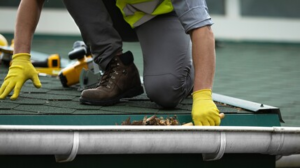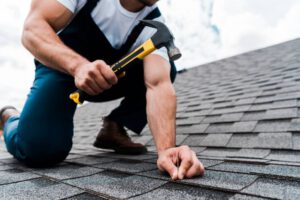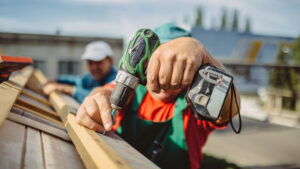Roofs take a lot of abuse from wind, rain, hail, and temperature extremes. Choosing Lancaster Roofing can help protect your home and its contents for many years.
Price is a consideration, but long-term durability and maintenance costs should also factor in. Other factors include your local climate and whether you have special requirements such as chimneys or unique roofing features like framed porches.

Weather protection is a key factor in choosing the right roofing material. A roof must be able to repel heavy rain, thunderstorms, hail and strong winds. It also needs to resist harsh sunlight and cold conditions. Some roofing materials are more suited to specific climates than others. For example, an asphalt shingle is a good choice for most climates, while a clay tile works best in arid regions.
Selecting the proper roofing material requires careful consideration of weather protection. A roof needs to be resistant to wind, hail, thunderstorms, and heavy rain. It must also be able to withstand extreme cold and sunshine. Certain climates are better suited for certain roofing materials than others. For instance, clay tiles function best in arid regions, while asphalt shingles are a good option in most climates.
When it comes to protecting your home from severe storms, extra insurance is always a wise investment. Make sure to carefully review your policy to ensure it covers damage from severe weather events and natural disasters. In addition, it’s a good idea to take inventory of your possessions and videotape or write down important information in case you need to file an insurance claim.
Purchasing additional insurance is usually a smart move when it comes to safeguarding your house against powerful storms. Make sure your policy covers damage from extreme weather and natural disasters by carefully reviewing it. It’s also a good idea to make a list of everything you own and record essential information on video or paper in case you need to submit an insurance claim.
Many construction projects require temporary weather protection, especially during the construction phase. Fortunately, there are many high-quality products available to meet the demands of construction sites across all four seasons. These products are designed and sized to fit the particular project and can be installed quickly and easily. Using these products can greatly reduce the risk of damage, delays and loss of revenue for contractors. They can also improve site safety and operational efficiency. Some of these solutions include:
Temporary weather protection is necessary for many construction projects, particularly during the building stage. Thankfully, a wide range of excellent products are available to satisfy the needs of building sites in all four seasons. These products are easy to install and can be quickly adjusted in size to suit the specific project. Contractors can significantly lower their risk of damage, delays, and lost revenue by using these products. They can also raise operational effectiveness and site safety. Among these options are the following:
Aesthetics is a broad term that describes the philosophy of beauty and taste. It is also a discipline that deals with how one perceives and responds to art, and the concepts upon which individual works of art are based.
Although some of the early thinkers made some forays into this area, a comprehensive philosophical analysis of the concept of beauty did not begin to develop until the eighteenth century. For example, the writings of the 3rd Earl of Shaftesbury, Francis Hutcheson, and Lord Kames are considered to mark the beginning of this line of thinking.
The field of aesthetics is a complex and vast subject. Many different philosophies exist on the topic, and it is difficult to determine what exactly defines an “aesthetic” object or experience. For instance, a person’s sense of aesthetic satisfaction may be based on various factors such as the senses, emotions, intellectual opinions, and even social and cultural values.
The study of aesthetics is a broad and intricate topic. There are numerous schools of thought on the subject, making it challenging to pinpoint the precise definition of what constitutes a “aesthetic” thing or experience. For example, a person’s subjective perception of aesthetic satisfaction can be influenced by a range of factors, including feelings, intellect, social and cultural values, and the senses.
One of the central issues in philosophical aesthetics is the question of whether there are any universal characteristics to be found within the concept of beauty. While there are many differences between individuals based on culture, custom, education and training, wealth and poverty, and religion, some aspects of beauty do seem to be shared by all humans. These include such things as the mother with child, the hero overcoming adversity and succeeding, and certain musical intervals and harmonies.
The question of whether the concept of beauty has any universal qualities is one of the main concerns in philosophical aesthetics. Even though people differ greatly from one another in terms of their culture, customs, education and training, wealth and poverty, and religion, there are some aspects of beauty that all people seem to find attractive. These include the mother carrying her child, the triumphant hero overcoming hardship, and specific musical harmonies and intervals.
While a roof’s function is vitally important, it can also add to the overall look and feel of a home or building. This is why it’s crucial to consider the aesthetics of roofing when replacing or constructing a new structure. Whether a homeowner wants to create a sleek modern design, rustic charm, or something in between, there are plenty of ways to make the roof aesthetically pleasing.
In addition to serving a functional purpose, a roof can improve the appearance and feel of a house or other structure. This is the reason that when building a new building or replacing an old one, the aesthetics of the roofing must be taken into account. There are many ways to make the roof visually appealing, regardless of whether the homeowner wants to create a sleek modern design, rustic charm, or something in between.
Aesthetics is a key component to any building or property, and it should be given the same level of attention and detail as other features and functions. By choosing the right colors, textures, and materials, homeowners can ensure that their roofing fits in seamlessly with the rest of their architecture and provides an attractive and pleasing visual appeal. This can lead to increased personal satisfaction, as well as increased value and functionality for the building.
Any building or piece of land must prioritize aesthetics, and just like other features and functions, aesthetics should receive the same care and consideration. Homeowners can make sure that their roofing blends in perfectly with the rest of their architecture and has a beautiful visual appeal by selecting the appropriate colors, textures, and materials. Along with increased building value and functionality, this may result in higher levels of personal satisfaction.
Investing in solar panels, collecting rainwater, and installing energy-efficient appliances are ways you can save money on utilities. But you can also reduce your energy costs by choosing the right roofing materials. For example, lighter shingles with more reflective coatings can lower attic temperatures and decrease cooling costs by 5% to 10% in warm climates. In addition, radiant barriers—sheets installed in the attic to slow conductive heat—can reduce cooling bills by another 5% to 10%. Talk to your local roofer about energy-efficient options for your home. They may even offer solar shingles that convert the sun’s rays into thermal or electrical energy.
You can reduce your utility costs by installing energy-efficient appliances, gathering rainwater, and purchasing solar panels. But by picking the appropriate roofing materials, you can also lower your energy expenses. For instance, in warm climates, lighter shingles with more reflective coatings can reduce attic temperatures and save cooling expenses by 5% to 10%. Radiant barriers, which are sheets put in the attic to slow conductive heat, can also cut cooling costs by an additional 5% to 10%. Consult your neighborhood roofer about energy-saving solutions for your house. They might even sell solar shingles, which use the sun’s rays to produce heat or electricity.




